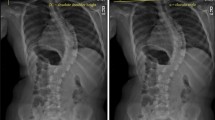Abstract
Purpose
Surgical correction for AIS has evolved from all hooks to hybrids or all screw constructs. Limited literature exists reporting outcomes using PHDS for posterior spinal fusion (PSF). This is the largest series in evaluating results of PHDS technique.
Methods
A retrospective review of consecutive AIS patients undergoing PSF by a single surgeon between 2006 and 2015 was performed. All eligible patients met a minimum 2-year follow-up. Patient demographics and radiographical parameters (radiographic shoulder height (RSH), T1 tilt, clavicle angle) at baseline, 6-week and 2-year post-operation were recorded. The primary outcome was difference in RSH from baseline measurements evaluated using repeated measures one-way analysis of variance with Bonferroni correction.
Results
A total of 219 patients (mean age at surgery: 13.68 years; 82% female) were included. The mean follow-up was 41.2 months (range 24–108 months). The RSH was significantly improved from − 14.7 ± 10.38 mm to 8.0 ± 6.9 mm (P < 0.0001). Clavicle angle was improved from 2.13° to 1.31° (P < 0.0001). T1 tilt was improved from 5.6° to 2.2° (P < 0.0001). At last follow-up, 95.8% of patients were shoulder balanced. There was a significant improvement of Cobb angle with an average correction of the upper thoracic curve of 42% and main thoracic curve of 67%.
Conclusion
The PHDS demonstrates the potential for additional shoulder balance improvement. Extension of fusion to structural proximal thoracic spine is the key to success for shoulder balance. It remains to be seen whether these improvements will translate into improved clinical outcomes in the longer term.

Similar content being viewed by others
References
Kim HJ, Blanco JS, Widmann RF (2009) Update on the management of idiopathic scoliosis. Curr Opin Pediatr 21(1):55–64
Kim YJ, Lenke LG, Kim J et al (2006) Comparative analysis of pedicle screw versus hybrid instrumentation in posterior spinal fusion of adolescent idiopathic scoliosis. Spine (Phila Pa 1976) 31(3):291–298
Hicks JM, Singla A, Shen FH et al (2010) Complications of pedicle screw fixation in scoliosis surgery: a systematic review. Spine (Phila Pa 1976) 35(11):E465–470
Kim YJ, Lenke LG, Cho SK et al (2004) Comparative analysis of pedicle screw versus hook instrumentation in posterior spinal fusion of adolescent idiopathic scoliosis. Spine (Phila Pa 1976) 29(18):2040–2048
Lowenstein JE, Matsumoto H, Vitale MG et al (2007) Coronal and sagittal plane correction in adolescent idiopathic scoliosis: a comparison between all pedicle screw versus hybrid thoracic hook lumbar screw constructs. Spine (Phila Pa 1976) 32:448–452
David MP, Hiroko M, Jaime AG et al (2013) Are breech rates for pedicle screws higher in the upper thoracic spine? Spine Deform 1(3):189–195
Akel I, Pekmezci M, Hayran M et al (2008) Evaluation of shoulder balance in the normal adolescent population and its correlation with radiological parameters. Eur Spine J 17:348–354
Li M, Gu S, Ni J et al (2009) Shoulder balance after surgery in patients with Lenke Type 2 scoliosis corrected with the segmental pedicle screw technique. J Neurosurg Spine 10:214–219
Kuklo TR, Lenke LG, Graham EJ et al (2002) Correlation of radiographic, clinical, and patient assessment of shoulder balance following fusion versus nonfusion of the proximal thoracic curve in adolescent idiopathic scoliosis. Spine (Phila Pa 1976) 27(18):2013–202
Suk SI, Lee CK, Kim WJ et al (1995) Segmental pedicle screw fixation in the treatment of thoracic idiopathic scoliosis. Spine (Phila Pa 1976) 20:1399–405
Bago J, Carrera L, March B et al (1996) Four radiological measures to estimate shoulder balance in scoliosis. J Pediatr Orthop B 5(1):31–34
Lee CK, Denis F, Winter RB et al (1993) Analysis of the upper thoracic curve in surgically treated idiopathic scoliosis. A new concept of the double thoracic curve pattern. Spine (Phila Pa 1976) 18(12):1599–1608
Benjamin TB, Zoe BC, Grant DS et al (2015) Do current recommendations for upper instrumented vertebra predict shoulder imbalance? An attempted validation of level selection for adolescent idiopathic scoliosis. HSSJ 11:216–222
Ono T, Bastrom TP, Newton PO (2012) Defining 2 components of shoulder imbalance: clavicle tilt and trapezial prominence. Spine (Phila Pa 1976) 37:E1511–E1516
Alvin HC, Marios GL, Xu G et al (2013) All-pedicle screw versus hybrid instrumentation in adolescent idiopathic scoliosis surgery a comparative radiographical study with a minimum 2-year follow-up. Spine (Phila Pa 1976) 38:1199–1208
Suk SI, Kim WJ, Lee SM et al (2001) Thoracic pedicle screw fixation in spinal deformities: are they really safe? Spine (Phila Pa 1976) 26:2049–2057
Lenke LG, Bridwell KH, O’Brien MF et al (1994) Recognition and treatment of the proximal thoracic curve in adolescent idiopathic scoliosis treated with Cotrel-Dubousset instrumentation. Spine (Phila Pa 1976) 19(14):1589–1597
Guixing Q, Jianguo Z, Yipeng W et al (2005) A new operative classification of idiopathic scoliosis: a Peking union medical college method. Spine (Phila Pa 1976) 30:1419–1426
Qianyu Z, Guixing Q, Qiyi L et al (2019) Modified PUMC classification for adolescent idiopathic scoliosis. Spine J 19:1518–1528
Kim YJ, Lenke LG, Bridwell KH et al (2007) Proximal junctional kyphosis in adolescent idiopathic scoliosis after 3 different types of posterior segmental spinal instrumentation and fusions: incidence and risk factor analysis of 410 cases. Spine (Phila Pa 1976) 32:2731–2738
Glattes RC, Bridwell KH, Lenke LG et al (2005) Proximal junctional kyphosis in adult spinal deformity following long instrumented posterior spinal fusion incidence, outcomes, and risk factor analysis. Spine (Phila Pa 1976) 30:1643–1649
Helgeson MD, Shah SA, Newton PO et al (2010) Evaluation of proximal junctional kyphosis in adolescent idiopathic scoliosis following pedicle screw, hook, or hybrid Instrumentation. Spine (Phila Pa 1976) 35:177–181
Author information
Authors and Affiliations
Corresponding author
Ethics declarations
Conflict of interest
No disclosure for this work.
Additional information
Publisher's Note
Springer Nature remains neutral with regard to jurisdictional claims in published maps and institutional affiliations.
Rights and permissions
About this article
Cite this article
Gajaseni, P., Labianca, L., Kalakoti, P. et al. Deformity correction using proximal hooks and distal screws (PHDSs) improves radiological metrics in adolescent idiopathic scoliosis. Eur Spine J 30, 686–691 (2021). https://doi.org/10.1007/s00586-020-06442-3
Received:
Revised:
Accepted:
Published:
Issue Date:
DOI: https://doi.org/10.1007/s00586-020-06442-3




